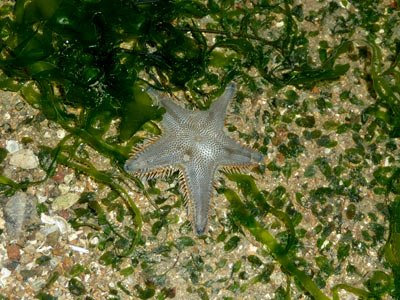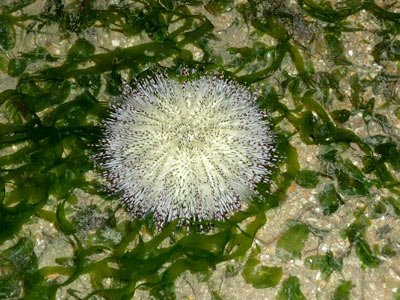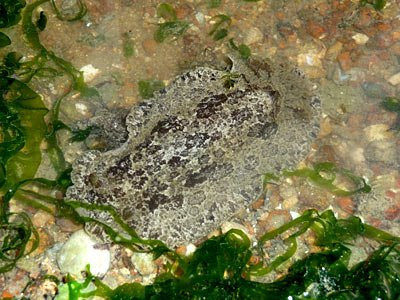This is one of those overdue posts again, as I was really busy last week :P
Went to Semakau Landfill again on Wednesday, but this time round, as a hunter-seeker. Didn't have time to take many photos, so here are just some of the interesting stuff that I managed to capture with my digicam.
Found this cute glossodoris nudibranch (Glossodoris atromarginata) on a black sponge when I was crossing the seagrass meadow. This nudibranch can secrete a milky chemical to make it distasteful when it is stressed.
The sandy area after the seagrass meadow has lots of sand-sifting sea stars (Archaster typicus). These sea stars can burrow into the sand to get away from predators and also to feed on organic particles (aka detritus) in the sand.
Here's a moon snail (probably Polinices mammatus) and a sand collar (moon snail egg capsules). Moon snails are fierce hunters that feed on other shells.
I managed to find one of our regular knobbly sea stars (Protoreaster nodosus) near the reef crest. Knobbly sea stars are usually the highlight of our guided walks, as they are probably the biggest sea stars that you can Singapore waters.
I also had another star find that day - a cushion star (Culcita novaeguineae)! After comparing the photos, this appear to be the same cushion star that we last saw in March 2007!
And the cushion star wasn't the only old friend who appeared that day. We also found this knobbly sea star which we last saw in June 2007! However, this one doesn't look too healthy. Some of its knobs have become black patches, though from the arrangement of the remaining knobs and the black spots I could still tell that it's the same sea star. Have no idea what's happening to it.
Here's another nudibranch we found, a Discodoris lilacina.
And I saw at least 6 noble volutes (Cymbiola nobilis) with their egg capsules!
There were several cowries too. This one looks like an ovum cowrie (Cypraea ovum) to me.
When we are heading back, I managed to grab a photo of the synaptid sea cucumber (Synaptidae) feeding on detritus with its tentacles among the seagrass.
On the whole, it was a good trip, despite the fact that it rained for quite while. Must say that we were really lucky that the rain eventually stopped and we managed to see some "old friends" during this trip!
Saturday, July 26, 2008
Semakau Walk on 23 July 2008
Wednesday, July 23, 2008
Sungei Buloh on a Weekday
Went to Sungei Buloh to conduct some workshops earlier this week. While we didn't get to see the crocodiles and otters, we still managed to spot many of the interesting flora and fauna, and here are a few of them...
Near the entrance to the reserve, RH spotted this jumping spider which has just caught its prey, a grasshopper.
A female student spotted this pretty paradise tree snake (Chrysopelea paradisii) at the shelter in the middle of the main bridge.
Every time we walk into Sungei Buloh, we'll definitely hear the calls of the cicadas.
I was really delighted to spot this huge orange mud crab (Scylla olivacea) among the prop roots of a mangrove tree.
We spotted not one, but two mangrove whiprays (Himantura walga).
There were many plantain squirrels (Callosciurus notatus) too.
On the whole, I was really glad that we managed to spot so many interesting stuff and the kids attending the workshop enjoyed it a lot too :)
Sunday, July 20, 2008
Exploring Pulau Sekudu
I've not been to Pulau Sekudu for quite a while, and thus was really looking forward to this trip, even though I had to wake up around 3am in the morning :P
We had to get a permit from Nparks to land on this little island, as it is part of Chek Jawa Wetlands, a protected area. A really good thing for the organisms in this area :)
We took a boat from Changi Point Ferry Terminal, and reached the island about 4.50am. Tide was already rather low and we started exploring the intertidal area immediately. Here are some of the things we saw during the trip :)
Pulau Sekudu has lots and lots of beautiful carpet anemones (Stichodactyla haddoni), and we had to walk really carefully around them so as not to step on them.
While many of the carpet anemones had green tentacles, some of them had purple ones instead.
The first sea star we saw was the sand star (Astropecten sp.). There must be hundreds of them in one of the lagoons! We saw a few every one or two steps!
Here's another type of sand star (Astropecten sp.), which we thought could be another species.
We also found an orange rock star (Asterina coronata).
A few medium size biscuit sea stars (Goniodiscaster scaber) were spotted as well.
Some how, we only managed to find one juvenile cake sea star (Anthenea aspera), and we didn't managed to find any knobbly sea star.
Not sure why, but there are some trips where we saw lots of seastars on Pulau Sekudu, and yet there were trips where I could hardly find any sea stars (even before the mass death which happened in January 2007). While we know that some marine life are "seasonal", we're not really sure what are the factors contributing to this, especially when many of the sea stars we saw are adult size, meaning they have to come from some where.
Anyway, there were quite a number sea cucumbers too, and of different species. The above is one of them, a pink thorny sea cucumber (Colochirus quadrangularis).
There were plenty of white salmacis sea urchins (Salmacis sp.) among the seaweeds too.
Pulau Sekudu is probably one of the best place in Singapore to see peacock anemones (Ceriantharia), and they come in all kinds of colours!
On the sides of several rocks, I found quite a few flatworms slithering around.
Found this little squid (probably Sepioteuthis sp.).
Somehow the noble volutes (Cymbiola nobilis) I've seen on our northern shores appear to be much bigger the ones I've seen on our southern shores. Not sure why.
I found this pretty little allied cowrie (Ovulidae) on a flowery soft coral.
Didn't really find many nudibranchs today, probably because I wasn't really looking for slugs today as I was searching for sea stars. Found the above nudibranch (probably Atagema intecta) near a rock while doing my star search :P
Some of the others found this nudibranch, probably a Discodoris lilacina.
When we're back on mainland at Changi, AP and I were waiting for our bus when I heard the calls of hornbills. Doing a quick scan around, I saw a pair of oriental pied-hornbill (Anthracoceros albirostris). Unfortunately, I only managed to take a few photos of the male hornbill.
Hornbills are frequently spotted at Changi and Pulau Ubin. In fact, I saw them on most of my trips to Pulau Ubin! :)
Saturday, July 12, 2008
Blooming of the Queen of the Night
Finally, my brother's Queen of the Night (Epiphyllum oxypetalum) bloomed again!
The Queen of the Night, also called epiphyllum, is a very pretty flower that blooms at night. Being a cactus that originated from the deserts in Central and South America, it is believed that the epiphyllum blooms at night as it is cooler and thus reduces water loss.
Some species of epiphyllums do bloom in the day, especially the hybrids which produce brightly coloured flowers.
Here's how the plant looks like. The word "epiphyllum" in Latin means "upon the leaf", and it's not hard to see how it gets this name from the photo above.
Sunday, July 06, 2008
Another Great Weekend at Semakau Landfill
We had two wonderful walks at Semakau Landfill over the weekend. I guided a group on Saturday, and was the hunter-seeker on Sunday.
My group's name on Saturday was "Pufferfish", and I had WP as my assistant.
Here's the group crossing the seagrass meadow. The seagrass meadow is a very important habitat for lots of marine life, as there are lots of food and hiding places among the seagrasses.
And here's the group again with the pufferfish look. Too bad they couldn't puff up their belly though. Haha :P
After crossing the seagrass meadow, we soon reached the sea star zone. And indeed, the sea stars were every where. These are the sand-sifting sea stars (Archaster typicus). They can burrow into the sand to feed on tiny organic particles called detritus, which can be dead organisms broken down into little bits, fragments of organisms or even fecal material.
Our next stop was the gigantic carpet anemone (Stichodactyla gigantea). This one wasn't very big though, its growth probably restricted by the little tidal pool it's in. This sea anemone has stinging tentacles to sting and capture little animals which got too close to it. The prey will then be transferred to the mouth at the middle.
Another anemone we saw was this Haddon's carpet anemone (Stichodactylla haddoni).
The noble volutes (Cymbiola nobilis) at Semakau seem to lay eggs all year round, and we had been seeing many of them doing that on most of our trips for the past one year.
We saw a spiral melongena (Pugilina cochlidium) laying eggs too. You can see that it blends in very well with the surrounding, and that's because a spiral melongena has lots of tiny hair on its shell that traps sediments, making it looks just like the sand around it.
This little fellow is a blue swimming crab (probably Thalamita crenata). Its two back legs were paddle-shaped that allowed it to swim. This is a rather aggressive crab. In some countries where they can be found, people do collect them for food, but they are usually not sold in the market probably because they are too small to have much meat compared to the other swimming crab species.
This was a great weekend for nudibranchs, and we saw several different species, including the chromodoris nudibranch (Chomodoris lineolata) above. Nudibranch means "naked gills", and the latter refers to the little flower-like gills exposed on the back of many nudibranchs.
We saw several glossodoris nudibranchs (Glossodoris atromarginata) too. Many nudibranchs can release chemicals that make them distasteful or even toxic to predators. This nudibranch belongs to the former, and it can release a whitish chemical to make it distasteful.
The pustulose phyllid nudibranch (Phyllidiella pustulosa) is a very toxic nudibranch which can release toxins into the surrounding water when it is stressed. It is said that the toxin released by a phyllid nudibranch can kill an entire tank of fish!
We saw a platydoris nudibranch (Platydoris scabra) again this weekend. All the above nudibranchs feed on sponges.
Can you find the octopus (Order Octopoda) above? Octopuses are masters of camouflage, and they can change their colour to blend into their surrounding. Singapore's octopuses are not very well-studied though, and thus most of the time we are not sure what species they belong to.
At the edge of the reef, we saw the resident fluted giant clam (Tridacna squamosa). This clam can grow up to 40cm wide, and are over-collected in many countries for food.
And once again, we also found the resident stinging anemone (Family Aliciidae). I've been finding it around the same area for the past one month. Hopefully it'll stay around there for good. This anemone is supposed to give very painful stings.
We saw many pretty corals, but I only remembered to took a photo of this sunflower mushroom coral (Heliofungia actiniformis). This is a free-living solitary coral, unlike most other corals that live in colonies attached to the substrate.
We also saw many different sea cucumbers, but I only took a photo of this sandfish sea cucumber (Holothuria scabra). This sea cucumber can burrow into the sand, and like the sand-sifting sea star, it feeds on detritus too.
And of course, the stars of our trip are always the knobbly sea stars (Protoreaster nodosus).
And here's the traditional group shot with the stars of the day :)
We found a few black long-spined sea urchins (Diadema setosum) too. The one above was found on Sunday when I was the hunter-seeker. This sea urchin feeds on algae with its mouth that is located on its underside.
On Saturday, we also found a file snake (Acrochordus granulatus) near the edge of the reef! This is the second time we saw live file snakes at Semakau near the reef edge. There's one time when we saw a dead one. This snake is non-venomous. Somehow, the file snakes on Semakau, at least the ones we've seen, are always covered with algae. Not sure why.
And YES! Our Pufferfish Group also saw a pufferfish (Family Tetraodontidae)! Pufferfishes are able to inflat themselves quickly with water or air, which supposedly could surprise their predator, thus giving them time to escape. Many puffers also contain a powerful neurotoxin, which could be lethal to those who eat them.
We were quite lucky to have found 3 seahorses (Hippocampus sp.) on Saturday, and 1 on Sunday. And one of the seahorses we found on Saturday was a pregnant male! Male seahorses share the burden of motherhood with the females. The females will lay eggs into a pouch located at the belly of the males, and eventually little seahorses will hatch inside the pouch.
On Sunday, we also found a cute little spotted-tail frogfish (Lophiocharon trisignatus)! Just look at how well-camouflaged it is!
Also on Sunday, we found this pretty purple climber crab (Metopograpsus sp.). This crab usually scavenges for dead animals on rocky shores.
Again on Sunday, I also found this huge sawedged spooner (Etisus utilis). The tip of its claws were spoon-shaped to allow it to scape algae off rocks to eat.
On Saturday, we also had a CNA crew following my group, and they interviewed some of the participants.
I'm certainly looking forward to see what aspects of this wonderful island that they have captured on film :)
